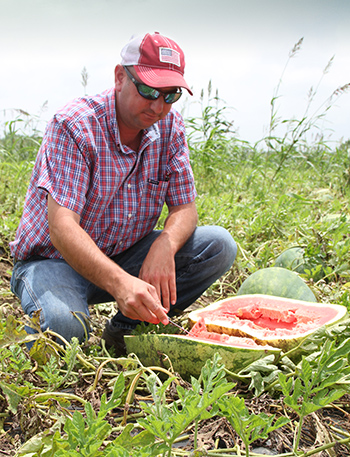Drenched Fields, Delayed Planting Put A Damper On Summer Season

Heavy showers, waterlogged fields, delayed planting and torrential rainfall from Tropical Storm Cindy dampened spirits for many farmers across Alabama this summer.
The state’s northwest corner received less than 5 inches of rain in June, but 16 or more inches soaked central Alabama, according to the National Weather Service. Twenty-plus inches saturated land nearer to the coast, such as Mobile County’s Sessions Farm.
Art Sessions said his farm’s fruit and vegetable season originally was promising, but 30 inches of rain from late May to late June caused water-damaged produce to split and ruin.
“We had the prettiest crop we’ve ever had,” Sessions said. “Now it’s gone.”
While certain ripe produce like watermelons, tomatoes and cantaloupes were ruined following Tropical Storm Cindy’s downpour, the Sessions had peppers, okra and late-season watermelons and tomatoes to harvest leading into the Fourth of July. The problem? Marketability.
“All the people we sell to are affected by the rain, too,” said Jeremy Sessions, Art’s son. “When it’s raining, people don’t get out and shop the way they do when it’s pretty weather. They don’t grill out like they would on a sunny weekend.”
Jeremy estimated a 40-percent sales decrease as the Sessions and other farmers faced closed markets because of unfavorable weather. To move perishable products, they delivered produce to customers farther north and decreased prices.
In Monroe County, row crop farmer Scott Saucer said he battled the worst planting season he’s ever seen, with rainy weekdays and weekends spent catching up in the field. He planted about 375 acres of peanuts in mid-May. From there, 2-5 inches of rain each week became the norm.
Tropical Storm Cindy poured 8 inches of rain between June 19-21, flooding Saucer’s fields. Thanks to tiles, ditches and drains, more than half the water receded less than 24 hours later.
“I think we’ll be fine as long as we get some sunshine in here and let everything start growing and catching up,” said Saucer, who also planted around 500 acres of cotton. “Mother Nature has a way of working things out. The older generation always told me you can make a crop in a wet year; you can’t make a crop in a dry year.”
Gov. Kay Ivey has requested disaster relief from U.S. Department of Agriculture (USDA) Secretary Sonny Perdue on behalf of Alabama farmers.
Perdue’s declaration would trigger damage assessments from USDA Farm Service Agency officials. Farmers in affected counties would then contact their local USDA service center to qualify for low interest loans.
Though the expected announcement would be welcome, Jeremy said creating more immediate forms of disaster relief is vital in upcoming farm bill discussions.
“This is a prime example of where farmers across the nation need a safety net that actually works,” he said, “so we can get some benefits out of it in a timely manner.”
Funding to relieve financial stress from last year’s extreme drought was made available through the Natural Resources Conservation Service in June. Eligible landowners were to apply by July 28 at their local USDA service center.
